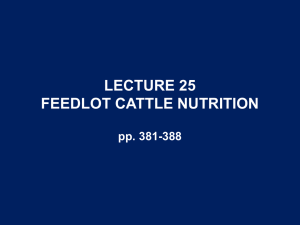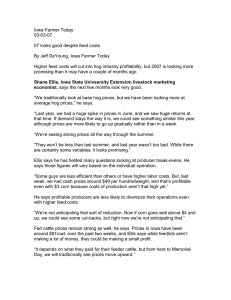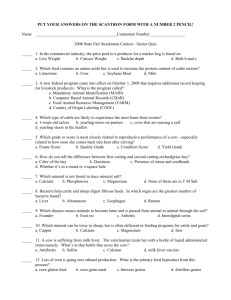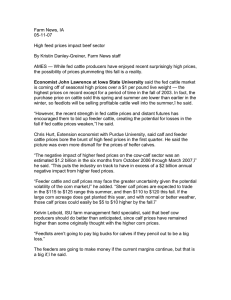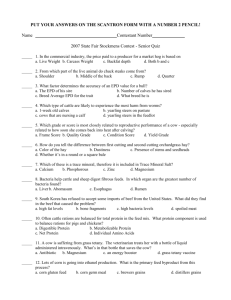LECTURE 20 FEEDLOT CATTLE NUTRITION pp. 409-418
advertisement
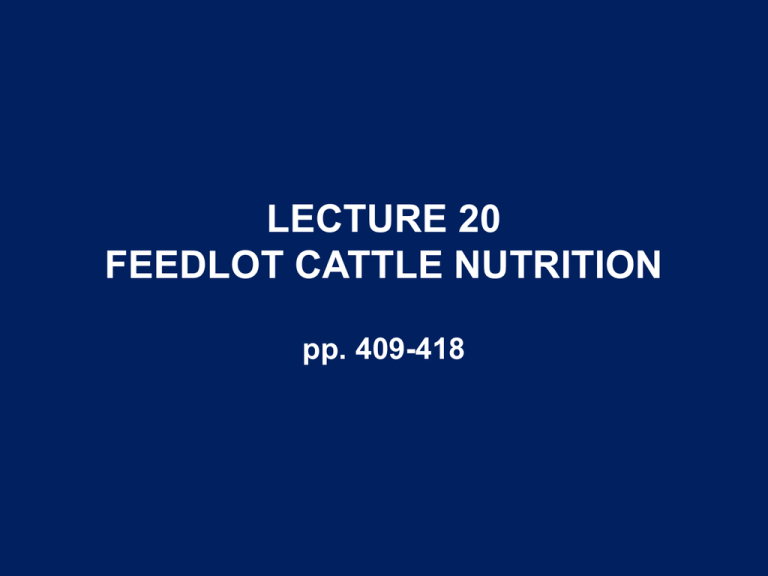
LECTURE 20 FEEDLOT CATTLE NUTRITION pp. 409-418 GOALS WHEN FEEDING FINISHING CATTLE • Maintain animal health • Produce a desirable carcass – Choice grade (5.0 to 8.5% intramuscular fat, 28% body fat) – – – – • Body weight will vary with genetics, growth rate, and implants Yield grade 3 or less Acceptable maturity (< 30 months) White fat and bright red muscle Carcass weight between 600 and 900 lbs • Minimize production costs – Feed – Non-feed costs (Facility depreciation, Interest etc) • Minimize environmental impacts – Maximize feed efficiency TRADITIONAL SYSTEM OF FEEDLOT FINISHING OF BEEF CATTLE Feeder calf or yearling (600-900 lb) Implanted with estrogen w/ or w/o Trenbolone acetate Feed high grain diet (80-90% grain) with ionophore Gain 3-4 lb/day Feed/gain 6-7 Harvested at 1200 –1400 lb producing a carcass with a choice quality grade and a yield grade of 2 or 3 Season prices: High in March and April Low in July FEED INTAKE OF FEEDLOT CATTLE • Normal intake is 2 to 3% of body weight • Factors – Degree of finish as affected by body weight, cattle type, implants etc. – Feeding after a period of restricted gain (backgrounding or grazing) • Part of compensatory gain – Diet • Ionophores • Forage concentration • Fat concentration • Nutritional imbalance – Potassium deficiency – Environmental • Temperature (base is 15 to 25 C) – Decreases by 10 to 35% if temperature increases to 35C – Increases by 16% is temperature decreases to -5 to -15C • Mud – Decreases by 15% if mud depth is 4 to 8 inches EFFECT OF BODY WEIGHT AND FATNESS ON FEED INTAKE Body fat DMI • Maintenance energy requirement of finishing beef cattle – NEm, Mcal/day = .077BW.75 – Modified by a large number of factors – Maintenance Modifiers Modifier Modification Change in NEm reqt. Breed Beef breed Base Dairy breed Increase by 20% Brahman breed Decrease by 10% Sex Bull Increase by 15% Previous nutrition BCS<5 Decrease by 5%/BCS unit ( Another part of compensatory gain) BCS>5 Increase by 5%/BCS unit Environmental stress Cold temp, dry coat, BCS 5 Increase by 15% (Include temp, wind, BCS, hide & coat thickness, coat cover and heat increment) Cold temp, dry coat, BCS 4 Increase by 20% Cold temp, snowy coat, BCS 5 Increase by 96% Heat stress Increase by 11 to 25% EFFECTS OF BODYWEIGHT ON THE NEm and NEg REQUIREMENT TO GAIN 3.5 lb/day FOR STEERS AT EITHER AT FINISHED WEIGHT OF 1200 OR 1400 LB ENERGY SOURCES FOR FEEDLOT DIETS • Grains – Fed at levels up to 95% of the diet – Usually are processed • Grinding, cracking or rolling • High moisture corn • Steam-flaking – Cattle must be properly adapted to diet – Limits Grain Maximum fed, % of DM Consideration Corn grain 92 Milo 92 Wheat 50 Highly fermentable starch Oats 25 High fiber, low energy Ground ear corn 95 (If no forage fed) High fiber • Grain processing byproducts Grain byproduct Maximum fed, % of DM Consideration Distillers dried grains w/ solubles (DDGS) 40 High sulfur, High fat Corn gluten feed 20-30 High fiber Distillers solubles 20 (If DDGS not in diet) High sulfur, high fat Soy hulls 25 High fiber • Fat supplements (Tallow, Vegetable-Animal Fat) – Increase energy concentration – Reduce dustiness – Limit to 5% of DM • Molasses – – – – – Increase energy concentration Reduce dustiness Increase palatability Increase binding of pellets Limit to 5% of DM ADAPTATION TO HIGH GRAIN DIETS • Rumen microbial population must be slowly adapted to high grain diets to prevent: – – – – Lactic acidosis Founder Polioencephalomalacia Bloat • Systems – Hand feeding • • • • • • Cattle fed forage for 4 to 7 days Start feeding grain at 0.5% BW Amount of grain increased at 1 lb/day to 1% of BW Amount of grain increased at 1/2 lb/day to full feed Decrease forage as grain increased Feed bunks must be monitored to ensure feed consumption – If intake decreases or ceases, slow rate of increase – Self-feeding a mixed ration Days Roughage:Concentrate 1-4 100% hay 5-8 50:50 9-13 40:60 14-17 30:70 18-21 20:80 22-25 15:85 26 10:90 – Supplementing Vitamin A at 30,000 to 50,000 IU/hd/day and Vitamin E at 400 to 800 IU/hd/day can assist in managing stress MEETING THE FIBER REQUIREMENTS OF FEEDLOT CATTLE • Need for fiber in ruminant diets – Stimulate rumination and saliva secretion – Prevents • • • • Parakeratosis of rumen wall Liver absess Acidosis Bloat • Requirement is for effective NDF (eNDF) – Includes fiber content and physical form of fiber • Requirements – 8% eNDF if: • Good bunk management, ionophore fed – 20% eNDF if: • Variable bunk management, no ionophore • eNDF concentrations of common feeds in feedlot diets – Feed eNDF, % of DM Ground corn stalks 65 Ground hay 51 Corn silage 33 Soy hulls 22 Corn gluten feed 13 Whole corn grain 10 Cracked corn 8 Ground corn 5 Distillers dried grains w/solubles 4 Soybean meal 3 • Metabolizable protein supply dependent on: – Ruminally undegraded protein – Microbial protein synthesis FACTORS AFFECTING THE PROTEIN REQUIREMENTS OF GROWING BEEF CATTLE • • • • Animal age and weight Compensatory gain Use of hormone implants Feed intake PRACTICAL IMPLICATIONS OF MP REQTS. OF FINISHING BEEF CATTLE • Cattle at light weights relative to finishing weight will benefit from sources of rumen undegradable protein – – – – Distillers grains w/solubles Corn gluten meal Expeller processed soybean meal Blood meal • Cattle at moderate weights only need to be supplemented with rumen degradable protein sources – NPN • Recall rules for safe use of NPN • Cattle near finishing weights obtain adequate metabolizable protein from a corn-corn silage diet with no protein supplementation • If DDGS are fed at 20 to 40% of the DM at any time during feeding, no protein supplementation is necessary MINERAL NUTRITION OF FEEDLOT CATTLE • Salt (NaCl) – Should be supplied at 0.25% of diet DM • Calcium and phosphorus – Feeds commonly used for feedlot diets contain low amounts of CA and adequate to high amounts of P Ca, % of DM P, % of DM Reqt 0.4 – 0.6 0.24 – 0.30 Corn grain 0.03 0.32 Corn silage 0.25 0.22 DDGS 0.26 1.0 – Add limestone to maintain Ca:P ratio of 2:1 • Prevents urinary calculi • Potassium – Borderline on high grain and corn silage diets – Monitor and supplement if: • Low feed intake • Heat stress • Sulfur – Toxic is fed at greater than 0.4% of diet • Causes polioencephalomalacia • Occurs at lower dietary levels of S if S content of water is high – May be a problem in diets containing high levels of Distillers dried grain w/ solubles • DDGS contain as much as 1.0% S – Management • Do not feed > 40% DDGS in cattle diets • Increase forage content of diet (15%) • Delay addition of high levels of DDGS until cattle adapted to grain • Use DDGS from plants that contain consistent levels of S • Supplement cattle fed DDGS with 150 – 200 mg thiamine/day • Trace minerals – Cu, Zn, Fe, Mn, Co, and I should be supplemented in a premix VITAMIN NUTRITION OF FEEDLOT CATTLE • Vitamin A – Supplement at 30,000 – 50,000 IU/d during adjustment – Supplement at 20,000 – 30,000 IU/d after adjustment • Vitamin E – Supplement at 400 – 800 IU/d for first 30 days in feedlot – Supplement at 500 IU/d during last 100 days in feedlot will improve product shelf life • Vitamin D – No need for supplementation if exposed to sunlight • B vitamins – Thiamine supplementation at 150 – 200 mg/d may reduce the risk of polioencephalomalacia in cattle fed DDGS – Other B vitamins not needed FEED ADDITIVES AND IMPLANTS FOR FEEDLOT CATTLE Feed additives Implants Class Products Effects Ionophores Monensin, Lasalocid, Salinomycin Increase propionic acid and decrease methane production in rumen, decrease feed intake, increase feed efficiency, increase ADG in cattle on high forage diets Progestogen Melengesterol acetate (MGA) Prevents estrus in heifers, increase ADG and feed efficiency B-agonist Ractopamine (Optiflex), Zilpaterol (Zilmax) Fed during last 28 – 42 days in feedlot. Increases ADG, feed efficiency, ribeye size and retail meat yield Estrogen Estradiol Progestogen Progesterone Increase rate of gain, feed efficiency, and protein gain Androgens Trenbolone acetate
